The Last Roman
Colonies Elevated under Philip I: Numismatic Perspective[1]
Abstract: /span>
Philippopolis in Arabia, Damascus and
Neapolis in Samaria were, besides Thessalonica, the last
colonies founded by the Romans. They were established under
Philip I, who originally came from the region where they were
located, thus they had a reason for being grateful. On the one
hand, the authorities of Damascus and Neapolis decided to
implement patterns of colonial coinage and to integrate with the
local tradition. On the other hand, ephemeral coinage of
Philippopolis highlighted the bonds with the imperial family.
This paper reconsiders
the coinage of the latest Roman colonies.
Key Words:
Roman Provincial coins
(http://nomisma.org/id/roman_provincial_numismatics), Roman
Colonies (https://www.wikidata.org/wiki/Q117025396); Philip I
(https://d-nb.info/gnd/11874223X);
Roman identity
Zusammenfassung:
Philippopolis in Arabien, Damaskus und Neapolis in Samarien
waren neben Thessalonika die letzten von den Römern gegründeten
Kolonien. Sie erhielten den neuen Status unter Philipp I., der
ursprünglich aus der Region stammte, in der sie sich befanden,
und hatten daher Grund zur Dankbarkeit. Einerseits beschlossen
die verantwortlichen Autoritäten von Damaskus und Neapolis,
gängige Muster kolonialer Münzprägung zu implementieren und sie
in lokale Traditionen zu integrieren. Andererseits betonte die
ephemere Prägung von Philippopolis die Verbundenheit mit der
kaiserlichen Familie.
Dieser Aufsatz betrachtet die
Münzprägung der jüngsten römischen Kolonien neu.
Schlagwörter:
Römische Provinzialmünzen, Römische Kolonien, Philip I.,
Römische Identität
Introduction
Five years of Philip’s
reign were a very dynamic period. First, he decided to establish
peace with Shapur I[2].
Then, the new emperor moved in a hurry to Rome to consolidate
his power. Meanwhile, his son Philip II became a Caesar. Once
their status was secured, the emperor marched against the Carpi[3].
He defeated them and returned to Rome as Carpicus Maximus
to celebrate the triumph. In April 248, the unprecedented event
of the thousandth anniversary of Rome’s foundation was
commemorated[4].
Philip Junior, at the age of ten, became a consul and Augustus[5].
Soon, a few usurpers appeared (Pacatianus in Moesia, Jotapianus
in Syria and Decius in Moesia). The last one eventually
overthrew Phillip and his son[6].
Aside from Philip’s military action, he also contributed
to the development of his native land (Arabia). His home village
(today’s Chahba in the Djebel Druse, Jordan) became a Roman
colony called Philippopolis[7].
Two other neighbouring cities of Damascus and Neapolis also
became Roman colonies under Philip[8].
It was a swan song of Roman colonisation[9].
The cities celebrated the new status with a series of coins
highlighting the relations with the emperor and Rome. The paper
analyses the Roman colonies’ coinage between 244–249 CE. The
significance of the last Roman colonies and their coins has not
yet been expressed. Therefore, the following questions are to be
answered. Was colonial title itself really that significant
since citizenship grants were no longer a concern following
the Constitutio Antoniniana? Were the coins of the last
colonies used to manifest the colonial rank? Did the new
colonies follow the patterns of colonial coinage? Did they
introduce imperial ideas into civic coinages?
Patterns of Colonial
Coinage
Before moving to the
analysis of coinages the latest Roman colonies, it is worth
explaining the patterns of colonial coinage. Among the numerous
coins belonging to the Roman provincial coinage, there is one
specific group of colonial issues. The coins struck in colonial
mints had a few distinctive features. This resulted from the
extraordinary status of the Roman colonies. They were modelled
on Rome itself. Aulus Gellius called them Coloniae quasi
effigies parvae simulacraque (Romae)[10].
The scholars often divided the Roman colonies into two groups;
›Veteran‹ which were established until Hadrian[11]
and ›titular‹ founded mostly under the Severi[12].
However, both types of colonies generally followed Roman
institutions, law, urban design, tradition and religion.
Therefore, colonial coinage was to a greater extent related to
the Roman tradition than other provincial civic issues.
Unfortunately, the mechanisms implemented are elusive to us; all
we know is the final product – Roman colonial coins.
The particular coinage
developed from the first century BCE up to the second century CE
in colonies inhabited by the veterans and their descendants.
First of all, the coins were inscribed in Latin. No matter where
they were located, Latin remained as the sole language from the
first century BCE up to the second century CE. In the third
century CE, most of the colonies continued to use Latin;
however, ten of the new established colonies decided to strike
bilingual or Greek coins[13].
Nevertheless, the status of the colony was almost always
highlighted on the coins, sometimes as a full name (COLONIA,
KOΛΩNIA) but more often as abbreviations (C, COL, KOΛ)[14].
In general, the colonial title typically appears first, followed
by the founder’s gens (Iulia, Augusta, Flavia, Aelia), next the
ethnikon, and then other titles (NEOKORATE, METROPOLIS)[15].
Another aspect of
colonial coinage is the iconographic programme. There are three
motifs that were predominant for colonies.
1. The ›foundation scene‹
presents a priest/founder ploughing a sacred furrow (sulcus
primigenius) with a yoke of oxen[16].
Romulus performed the aratrum (plow) rite when he first
established Rome, and it was afterwards repeated in the case of
new colonies. Therefore the coins with the foundation scene
commemorate the colonial birthday.[17]
2. Military standards (aquilae,
vexilla, signa) indicating the legions that the colonists
came from. The aratrum ritual highlights the civic
origins of the colony, while the legionary emblems indicate the
military past of the colonists[18].
3. The figure of Marsyas
appeared on the coins of the Roman colonies for the first time
under Domitian in Sinope[19]
and became a common motif on colonial coins in the third century
CE. It is perceived by scholars as the symbol of colonial
liberty (signum libertatis)[20].
It seems that these three motifs were to some point reserved
exclusively for the Roman colonies.
The aforementioned
patterns were developed in the veteran colonies in the
first-second century CE. However, the late colonies, which were
established in the early third century CE, often defined as
›titular‹, followed the patterns that originated from the
›regular‹ ones. A total number of 24 Roman colonies struck coins
under Philip I[21].
They were spread from Thrace (Deultum) to Mesopotamia (Nisibis).
Despite geographical differences, colonial coins had the
aforementioned features. In spite of domination of the local
motives in the third century, Roman identity was manifested to
some extent in the colonies.
Finally, three cities
that gained the colonial status under Philip I immediately
released initial colonial issues[22].
Did Damascus, Neapolis and Philippopolis also reorganize civic
coinage after colonial grants?
Colonies founded by
Philip I
Philippopolis
As was said before,
Philippopolis (Chahba) was a supposed place of Philip’s birth[23].
After taking the throne, the new emperor decided to elevate his
home village to the rank of a colony. Judging by the remnants,
Philippopolis was rebuilt as an ideal Graeco-Roman city, yet
there is no evidence of Roman settlers[24].
Obviously, no coins were minted there before the elevation.
Furthermore, after the assassination of the imperial family,
Philippopolis did not continue coin production.
An elevation of a new
Roman colony was manifested by a few issues struck in the name
of ΦΙΛΙΠΠΟΠΟΛΙΤΩΝ ΚΟΛΩΝΙΑC[25].
No colonial motifs were introduced and the Latin was not in use
there (excluding the S C mark). The iconographic repertoire was
limited to three reverse types bearing Roma. On the large issues
(12–18 g), Roma was sitting (fig. 1)[26].
On the medium units (7–8 g), the goddess was standing[27].
On the small issues (4 g), only the bust of Roma was depicted[28].
The design of the sitting helmeted Roma holding a sceptre could
be copied from imperial issues[29].
However, an almost identical depiction of Roma is presented on
colonial issues of Laodicea Maritima[30].
In the case of Philippopolis, the design was altered. Roma is
not holding a victory but two small figures mounted on an eagle.
The presentation of Roma was an evident manifestation of loyalty
and gratitude towards Rome. The small town, or a village even
was converted into a Roman imperial city. Due to the fact that
there was no tradition of local coinage, the issues in the time
of Philipp I could have been produced elsewhere or by minters
from another city. Laodicea is an obvious candidate; however,
there are confirmed die-links between Philipopolis and Antioch[31].
The die-network in the Levant requires further research, yet the
connections between Philippopolis and other Roman colonies are
striking. Was it a conscious decision to follow colonies in
minting? or it was just a coincidence? It is impossible to
solve.
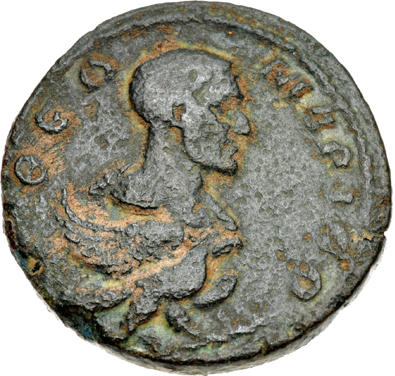
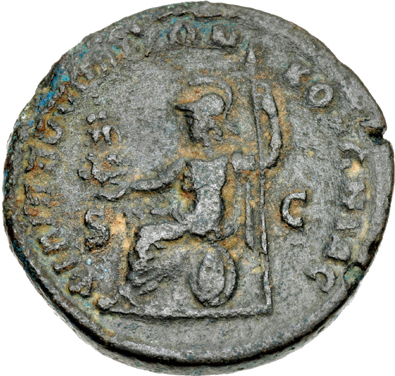
It must be highlighted
that the local authorities wanted to emphasise the emperor’s
origins. Besides members of the ruling imperial family (Philip
I, Philip II and Otacilia Severa), coins also bear the depiction
of the emperor’s father on an eagle- Julius Marinus[32],
who had been a regional elite’s member of an equestrian rank[33].
After Philip’s ascension, Marinus was deified by his son and
worshiped in Philippopolis[34].
A bust of Marinus (ΘЄΩ ΜΑΡΙΝΩ) is
supported by an eagle (fig. 1)[35].
The presence of Philip’s father on coins was exclusively
restricted to Philippopolis. He was never depicted on either
imperial or provincial issues. Therefore, the figure of Marinus
performed the role of the local benefactor (just like Pythagoras
on Samos coins[36])
while his son became the founder of a newly established city.
Furthermore, on another
issue an enthroned Roma is holding two figures also supported by
an eagle[37].
Since Jupiter’s bird supporting deceased emperors and empress
symbolised their apotheosis[38],
the figures can be identified as deified Philip’s parents.
However, Achim Lichtenberger argues that Philip I and perhaps
his brother Iulius Priscus are presented on that issue[39].
Nevertheless, the authorities of the new colony chose not to use
a local hero or to refer to coinage tradition, so they availed
popularity of the imperial family members, descendants of their
own land.
As it was mentioned
above, the legends on Philippopolis coins are inscribed in
Greek. The mother city of Philip I was among the ten Roman
colonies that never converted to Latin[40].
Yet, two Latin letters (S C) appeared on almost all coins issued
in the name of the Philippopolis colony. Senatus Consulto
(S C) suggests that minting rights came from the central
government. The scholars describe Greek coins with a
conventional mark of authority in Latin (S C / S P Q R) as
pseudo-bilingual[41].
It is important to highlight that only two other centres used S
C on coins under Philip I: Antioch ad Orontem[42]
and Mallus[43].
Both cities were also colonies established in the third century.
Mallus introduced the abbreviation after its transformation into
a Roman colony, while Antioch ad Orontem used it for much
longer, from Augustus till 253 AD. It is another connection
between Antioch and Philippolis (mutual use of S C abbreviation
and die-links). This seems to support the theory that coins in
the name of Philippopolis were actually produced in Antioch or
executed by Antiochene minters. In conclusion, the colonial
authorities attempted to manifest Philippopolis as an imperial
city through the employment of the S C formula, the introduction
of Roma, and members of the imperial family.
Damascus
Damascus did not issue
coins after the death of Elagabalus. Local mint was reopened
under Philip I, the initial issues bore the universal colonial
features for the first time. Therefore, it can be assumed that
Damascus became a Roman colony under Philip I[44]
and not earlier in the times of Septimius Severus[45].
In contrast to
Philippopolis, the government of the new colony actually decided
to follow universal colonial patterns. Latin was accepted as the
main language of legends, yet not as a sole one. All typical
colonial motifs appeared on coins. The difference in attitude to
the colony of Philippopolis located 85 km to the southwest of
Damascus is striking. In contrast to Philippopolis, there is
numismatic evidence that actual settlers were located in the
city, since military standards were depicted on Damascene coins
under Philip I[46].
Vexillum of Legio VI Ferrata (inscribed LEG VI
FER) is juxtaposed with the aratrum ritual[47]
and she-wolf nursing twins (fig. 2)[48].
It is important to highlight that Lupa Romana was an
emblem of Legio VI Ferrata; therefore, the composition
indicates a military tradition. Furthermore, an almost identical
depiction appeared on the one known specimen of Philip I in Tyre[49].
Edward Dąbrowa argues that the veterans of Legio VI Ferrata
could have settled under Philip I in both Damascus and Tyre[50].
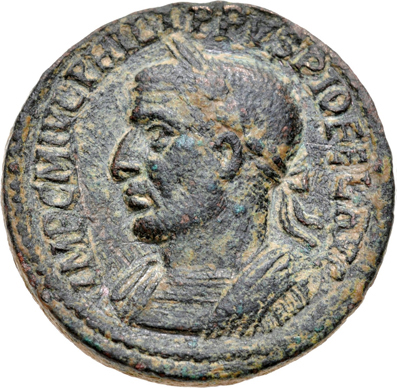

The iconographic
programme introduced after the transformation into a colony was
unprecedently versatile in the case of Damascus. There was a
wide range of typical colonial motifs such as the aforementioned
vexilla set up with Lupa Romana[51],
foundation type[52]
and Marsyas[53].
However, the local tradition remained strong. Damascene games –
Sebasmia – were also held after the elevation[54].
It is important to highlight that agonistic crowns[55]
and wreaths[56]
had been earlier presented on coins[57].
After colonial grant agonistic crowns depicted on coins were
actually inscribed in Greek (ΑΓΙΑ ΙЄΡΑ CЄΒΑCΜΙΑ), while the
surrounding legend remained Latin (e.g. COL DAMA(S) METROP) (fig.
3). In contrast to Philippopolis in which pseudo-bilingual
coins were struck, Damascene issues are truly bilingual. Other
Greek words that appeared on coins under Philip I are ΠΗΓΑΙ
(stream / water source) and ΧΡΥCΟΡΑ
(Chrysoroas = river-god)). The inscriptions are used to identify
certain contexts or figures (explained below), that engravers
presumed to be unclear. Since they used the Greek language to do
that and the fact that Damascus is often written with
Δ instead of D, it
seems obvious that the local community primarily used Greek.
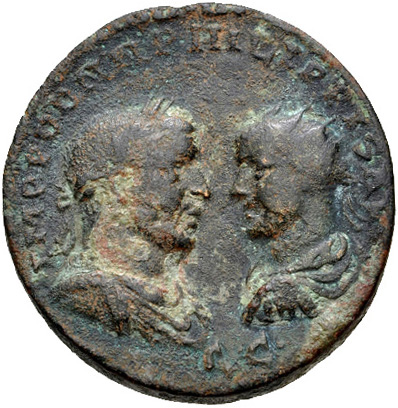
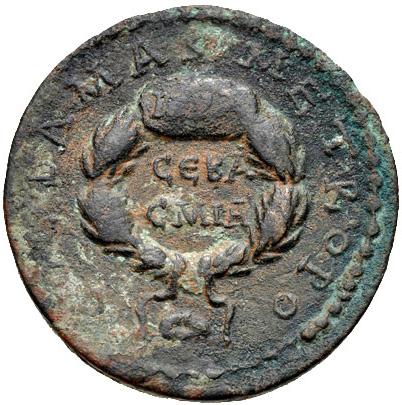
A Sanctuary consecrated
to river-god Barada (Chrysoroas) is another sign of local
patriotism on Damascene colonial coins[58].
The sanctuary (nowadays Ayn al-Fijeh), located north-east of
Damascus, was famous for a stream spring coming out of a grotto[59].
The composition presenting the sanctuary on coins consists of
two registers. A grotto with a cult statue of Chrysoroas is
depicted on the lower one. A tetrastyle temple with a statue of
the unidentified figure (Marsyas? Female figure?) is presented
above[60].
The scene is completed by Greek inscription ΠΗΓΑΙ, which means
streams or a water source[61].
A composition seems to be another manifestation of the
integration between the colonial and the local tradition.
Furthermore, the sitting figure of Chrysoroas, inscribed in
Greek – ΧΡΥCΟΡΑ, is also the main theme of a few issues’
reverse (fig. 4)[62],
what makes river-god another example of continuity of local
coinage[63].
The life-giving waters of Chrysoroas irrigated the gardens and
plantations of Damascus. The region was famous for local fruits
such as plums and figs, but also pistachios and olives[64];
therefore, a well-organized irrigation system was essential for
the local economy.
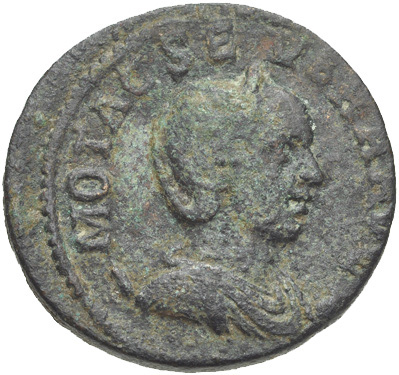
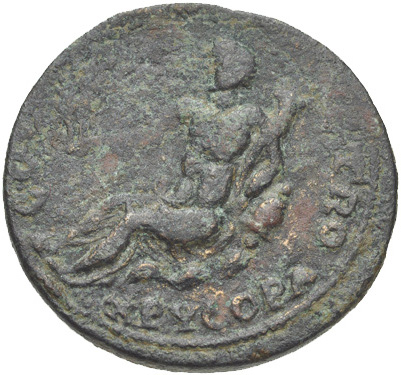
One of the most
important figures in civic coinage was a city goddess
(Tyche-Fortuna- Astarte) presented in various configurations[65].
On a multifigured scene, the sitting Tyche is juxtaposed with a
statue of Marsyas on the upper register (fig. 5)[66].
On the lower register, two central Tychai are raising an object
which seems to be a fruit basket (perhaps containing damascene
plums and figs). On another issue, an emperor is accepting a
diadem from a thankful Tyche[67].
Damascus is flourishing after the elevation into a Roman colony.
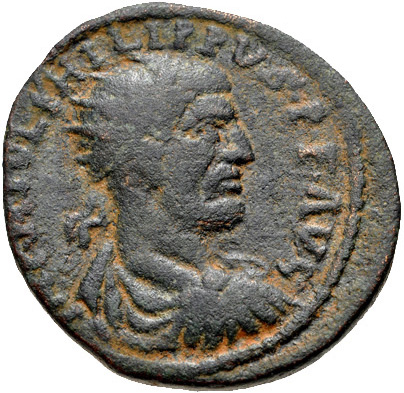
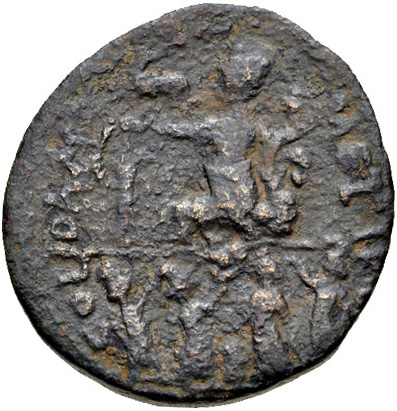
Other gods and heroes
depicted on Damascene coins were Hercules[68],
his son Telephos[69],
Ambrosia (fig. 6)
[70]
and Lycurgus[71].
Especially the presence of the last two heroes is uncommon. The
depiction of the naked female figure tangled with vine tendrils
was primarily identified with Daphne[72].
However, Kevin Butcher has argued that such a configuration
matches with Ambrosia[73].
According to Nonnus’ Dionysiaca, Ambrosia saved Dionysus
by strangling his rival Lycurgus in a battle fought somewhere in
Syria[74].
Furthermore, this act seems to be presented on another coin[75].
Ambrosia is spreading vine tendrils to prevent the advancing of
Lycurgus. The scene was shown on a famous Rothschild’s Lycurgus
Cup from the fourth century AD[76].
There are other figures on the Damascene colonial coinage yet to
be identified[77].
Syrian mythology may have been preserved in certain ways through
Nonnus story, which could lead to the hybridity of figures like
Ambrosia and unidentified heroes.
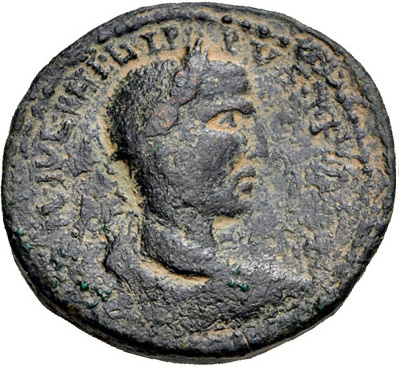
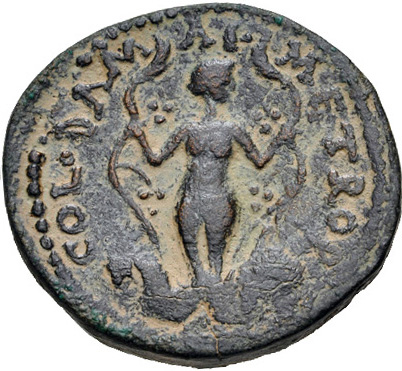
Nevertheless, the
mintmark of Damascus was a ram’s head[78]
or a leaping ram[79],
which was also presented as a solo theme on the reverse[80].
Altogether, the reorganised mint of colonial Damascus introduced
an unprecedented abundant iconographic repertoire. Both local
and colonial. In contrast, the last pre-colonial issues struck
under Elagabalus presented only five themes[81].
It simultaneously demonstrates how Damascus and Philippopolis
take different approaches.
In short, Damascene
coinage after the transformation into a Roman colony is a
manifestation of syncretism; in other words, by combining
aspects of two traditions, a new cultural expression was
created. Traditional motifs were implemented with predominant
colonial motifs. This phenomenon is illustrated by the statue of
Marsyas rising a hand towards a cypress tree (another symbol of
Damascus) (fig. 7)[82].
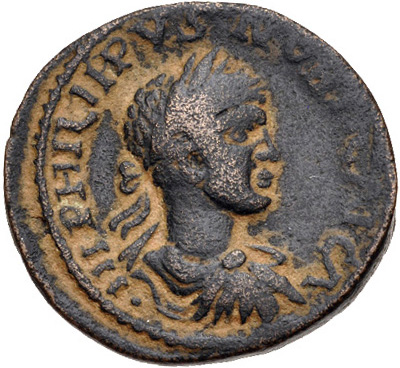
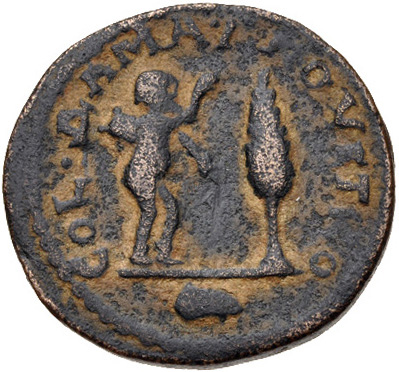
Neapolis
The third city that was
elevated to the status of a colony was Samarian Neapolis. The
transformation took place in the second period of Philip’s reign
(247–249 AD), since his son was being recognised by inscriptions
as Augustus[83].
We learn from the coins that the city gained also
neokorate under Philip I[84].
Coinage of Flavia Neapolis under Philip I has been recently
carefully investigated by Lior Sandberg[85].
Therefore, in this paper, a few aspects of the Neapolis’ coinage
connected with the colonial and local identity are emphasised.
Similar to Damascus, the
mint of Neapolis was closed for some time before reorganisation
as a colonial mint. The last issues before the break were
released under Severus Alexander[86].
Only four themes were presented in the times of the last member
of the Severan dynasty[87].
By contrast, after the colonial grant, a wide range of colonial,
imperial and local motifs were introduced under Philip I. Most
of them were signed by a depiction of Mt. Gerizim. The holy
Samarian mountain symbolised the city itself[88].
The depiction was presented in two versions. A relatively large
mintmark with a detailed staircase and two peaks with a temple
and shrine of Zeus Hypsistos[89]
were often juxtaposed with an eagle (fig. 8)[90]
and Lupa Romana[91].
In the smaller version, it was put in the background of e.g.
the foundation scene[92].
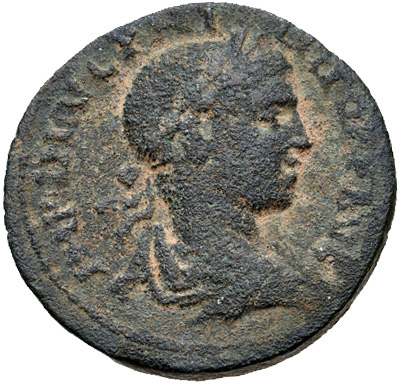
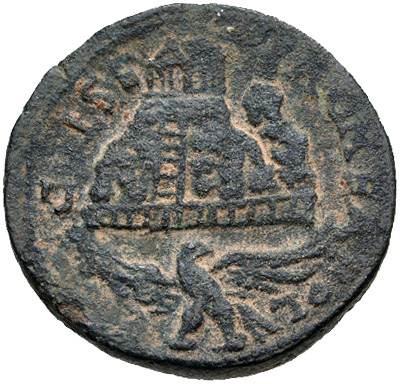
There are two colonial
motifs presented on coins of Neapolis: a relatively large figure
of Marsyas was juxtaposed with Mt. Gerizim supported by an eagle[93]/
Nike[94]
and the foundation scene[95].
One could be surprised that military emblems were omitted.
According to Kenneth Harl, the lack of vexilla on
Neapolis coins in the times of Philip’s reign suggests
the titular nature of Colonia Sergia Neapolis[96].
However, behind oxen heads there is an uncertain object (barely
visibly) that could be vexillum. In fact, there are coins
from the Trebonian Gallus times, struck in Neapolis and feature
images of Mount Gerizim, Neptune, and a military sign with a
boar[97].
The animal served as a symbol of Legio X Fretensis, whose
veterans had been settled in another colony, Aelia Capitolina[98].
Therefore, it is reasonable to believe that some veterans /
legionaries may have participated in Neapolis’ colonial history.
The foundation scene was
known from a few issues. A founder driving a yoke of oxen is
acting the aratrum ritual at the foot of Mt. Gerizim (fig.
9). According to Sandberg, the depicted founder is actually
the emperor[99].
Nevertheless, whether the priest was portrayed to be Philip or
whether he was a default colonial founder, the scene
commemorates the colonial foundation on a basic level and could
be celebrating the millennium of Rome on a deeper level.
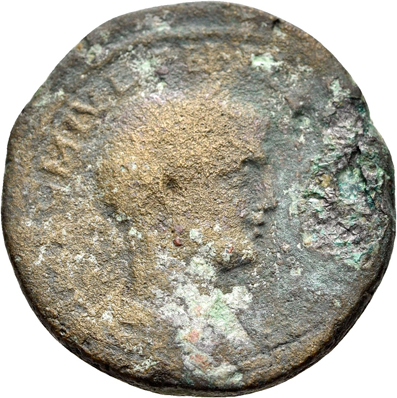
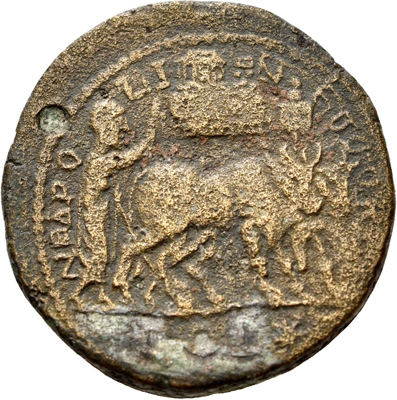
One could say that the
introduction of Lupa Romana in newly established colonies
like Neapolis[100]
and Damascus[101]
is a direct link to the millennium of Rome celebrated in
248 AD[102].
Since the proof of saeculum celebration on
imperial coinage are issues bearing Lupa Romana and the
inscription SAECVLARES AVGG[103].
The motif of a she-wolf nursing twins was absent from imperial
coins from the times of Marcus Aurelius and re-appeared under
Philip I to celebrate ludi saeculares[104].
However, in the case of provincial coinage, the motif of
Lupa Romana used to be frequently presented both in colonies[105]
and peregrine cities[106].
It was a way to manifest loyalty towards Rome. Furthermore,
colonies could have been emphasising direct connections with
Rome. In contrast to Damascus, there is no evidence of Legio
VI Ferrata presence; therefore, the juxtaposition of Lupa
Romana and the sacred mountain of Samarian could be another
expression of syncretism.
Sandberg connects the
issues depicting Decanus[107],
Demeter with Kore[108],
the foundation scene[109]
with the commemoration of the saeculum games held in the
city[110].
The scholar makes an attempt to identify the star depicted on
the coin with Decanus as sidus Iulium[111];
however, the star of Julius was barely in use after Augustus
death and shall be reserved for the Julio-Claudian dynasty[112].
The benefactors of
Neapolis were also included on local coinage. Once, the sitting
emperors were receiving Fortuna of Neapolis which was holding a
wreath[113].
City-goddess was going to honour the emperors in an act of
gratitude for the colonial and neokorate titles, what
actually happened on another issue where Fortuna was crowning
the sitting Philip I, surrounded by Philip II and a grateful
citizen (fig. 10)[114].
The emperors were also presented on other issues[115].
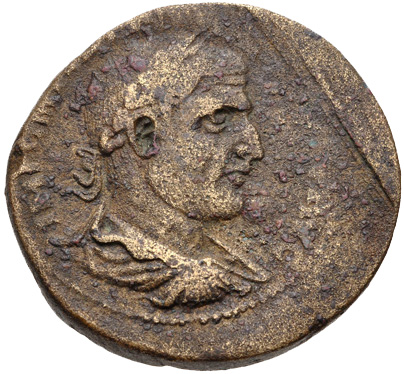
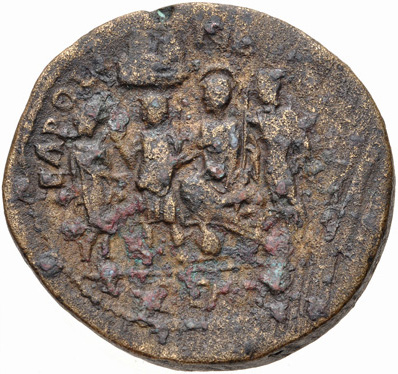
There were numerous
heroes and goddesses, some of them still require identification.
The most important god worshipped in the city was Jupiter (Zeus
Hypsistos), depicted in a few ways[116].
His temple was erected on a peak of Mt. Gerizim under Hadrian[117].
Recently, Andreas Kropp identified the altar of the other peak
with the one presented on Caracalla, suggesting that Fortuna,
Artemis and Kore Persephone were worshipped there[118].
Other gods were Roma, Mars, Triptolemos, Serapis, Salus,
Asclepius, Cybele, Capitoline triad. However, the most enigmatic
one was linked to the Samaritan religion. According to
tradition, on Mt. Gerizim Abraham was supposed to sacrifice his
son – Isaac (aketah)[119].
Some scholars identify the scene of binding of Isaac with issues
bearing four figures and a lamb[120].
However, two known examples were in a too poor condition to make
the final identification.
Bilingual coins also
appeared in Neapolis under Philip I. The aforementioned Decanus
is inscribed in Greek (ΔЄΚΑΝΟϹ)[121].
One should note that a similar pattern was introduced in
Damascus. Furthermore, there are some errors in imperial names.
Both emperors are inscribed as IIMM CC P FILIPPIS AVGG[122],
in another case Philip II as IMP C M IVL PHELIPPO P F AVG[123].
Engravers executing the dies for Neapolis had evident spelling
difficulties.
Conclusion
Thus to summarise,
besides Thessalonica, three colonies established under Philip I
are considered to be last Roman colonies. They were elevated in
the final stage of Roman provincial mintage and simultaneously
gained imperial grant to open or reopen local mints. At the
time, colonial mints could be divided into two groups: mints
which followed the patterns of colonial coinage (Latin
inscriptions; universal motives), and those which introduced a
new status of colonia among other titles in a legend.
Coinage of Philippopolis is among the latter group. By contrast,
the local authorities of Neapolis and Damascus decided to follow
patterns of colonial coinage.
In fact, the coinages of
Damascus and Neapolis share common features. First of all,
reopened mints were significantly subsidized, and as a result,
dozens of iconographic motives, both local and colonial were
released. The statue of Marsyas symbolising a new colonial
status, the ›foundation scene‹ emphasising the bonds with Rome,
military standards and Lupa Romana were adopted into the
iconographic programmes. The colonial motifs supplemented a long
tradition of local coinages. They were not used to express the
dominance of Rome, but rather to integrate two identities.
Moreover, the existence of bilingual coins with Latin legends
and Greek signatures of local heroes and games is another aspect
of a syncretic culture. Although a familiarity of Latin was
superficial, the colonial governments manifested a cultural and
political affiliation to the Roman identity.
Furthermore, depictions
of members of the imperial family performed an important role in
both colonies. Tyche accepting a
diadem from Philip I in Damascus[124]
or Tyche crowning emperor in Neapolis[125]
highlight that a new status of both cities came directly from
the emperor and his family.
Compared with Damascus
and Neapolis, a gratitude towards the emperor was far more
emphasised in Philippopolis. An enormous construction project
took place in the hometown of Philip, transforming it into a
magnificent city. A short-lived mint of Philippopolis did not
have a tradition of coin production nor local heroes or
sanctuaries, therefore, the imperial family, including the
predecessors of Philip, were manifested there. In order to
establish a local distinctive identity, members of the
autochthonous elite who were successful in obtaining imperial
authority were juxtaposed with Roma and a new colonial status.
Damascus and Neapolis
were the last provincial mints that joined the family of Roman
colonial coinage. They followed universal patterns developed
hundreds of years earlier, and combined them with a local
tradition. Why did Damascus and Neopolis accept colonial
practices is the last outstanding question. In the text, there
are two potential responses. On the one hand, the emergence of
colonial motives (particularly the legionary standards of
Legio VI Ferrata in Damascus and the ambiguous vexillum on
the coins of Neapolis) raises the possibility that legionaries
and veterans would settle in these colonies. On the other hand,
becoming a member of the reputable group of Roman colonies was
such a significant honour that the local government manifested
it on local coins.
After the assassination
of Philip, a syncretic approach in Damascus and Neapolis was
continued but not for long. The last emissions from Neapolis
were released under Trebonianus and from Damascus under
Gallienus. It was a swan song of colonial coinage.
[1] The
presented research is financed by the National Science
Centre of Poland, project 2018/29/N/ HS3/01502 »The
Roman Colonial Coins as a Manifest of Cultural Identity
235–275 AD«.
[2] Zosim.
1,19.
[3]
Zosim. 1,20.
[4]
Kluczek 2019, pp. 226–234.
[5]
Hekster 2008, p. 4.
[6]
Zosim. 1,22.
[7]
Butcher 2003, p. 223. Millar 2006, p. 168.
[8]
Millar 2006, p. 216, Sandberg 2019, p. 141.
[9] The
last city that gained the status of Roman colonia
was Thessalonica under Trajan Decius. Burrell 2004, pp.
198–203; Millar 2006, pp. 216–217.
[10]
Gell. NA 16,13,9.
[11]
Sherwin-White 1973, p. 351; Boatwright 2000, p. 36;
Butcher 2003, p. 230; Andrade 2013, pp. 319–323; Coles
2020, p. 77.
[12]
Dąbrowa 2004a, pp. 394–405; Millar 2006, p. 165;
Katsari, Mitchell 2008, p. 242; Dąbrowa 2020, pp.
97–104.
[13]
Thessalonika, Tyana, Antioch ad Orontem, Emesa,
Philippopolis, Carrhae, Edessa, Nisibis, Rhesaena and
Singara.
[14]
Katsari
– Mitchell
2008, p. 221.
[15]
There are situations in which colonial status is
removed, though. For instance, Corinth hardly ever
depicted its colonial status on coins. Furthermore,
there are series of coins of Neapolis with legends:
NEAPOLI NEOCORO, COL in exergue (e.g.
RPC VIII
unassigned 2340)
[16]
Jellonek 2018, pp. 104–107.
[17]
Papageorgiadou-Bani 2004, pp. 35–36;
Filges 2015, pp. 243–249.
[18]
Dąbrowa 2004a, p. 399.
[20]
Klimowsky 1989, pp. 93–94;
Basso, Buonopane 2008, pp. 139–160.
[21]
Deultum, Viminacium, Dium, Cassandrea, Pella, Parium,
Apamea, Sinope, Pisidian Antioch, Cremna, Comama,
Alexandria Troas, Mallus, Antioch ad Orontem, Tyre,
Heliopolis, Laodicea Maritima, Ptolemais, Caesarea
Maritima, Bostra, Nisibis, Damascus, Neapolis and
Philippopolis.
[22]
Philippopolis, Damascus, Neapolis.
[23]
Spijkerman 1978, p. 258; Ball 2000, p. 204; Butcher
2003, p. 232; Millar 2006, p. 217; Oenbrink 2006, p.
243.
[24] Ball
2000, p. 204; Butcher 2003, p. 233; Darrous – Rohmer
2004, pp. 5–41; Oenbrink 2006, pp. 253–260.
[27]
RPC VIII
2196,
2243
(unassigned).
[28]
RPC VIII
2210 (unassigned).
[29] E.g.
RIC IV Philip I 44,
45;
Balbuza 2013, p. 413; Balbuza 2014, pp. 189–190.
[30]
RPC VIII 8024
(unassigned).
[31]
Butcher 1988, pp. 70–71.
[32]
RPC VIII
2243,
2417,
2449
(unassigned).
[33]
Darrous – Rohmer 2004, pp. 23–24; Millar 2006, p. 217.
[34] BMC
Arabia, Mesopotamia and Persia, p. XLI; Butcher 2003,
pp. 233–234; Darrous – Rohmer 2004, p. 14; Millar 2006,
p. 217.
[35]
RPC VIII
2243 (unassigned).
[38]
Spijkerman 1978, p. 259; e.g Diva Sabina
RIC II.3 2603; Diva Faustina
RIC III 1133; Divus Marcus Aurelius
RIC III 660.
[39]
Lichtenberger 2006, pp. 188–189.
[40]
Thessalonika, Tyana, Antioch ad Orontem, Emesa,
Philippopolis, Carrhae, Edessa, Nisibis, Rhaesaena and
Singara.
[41]
Calomino 2014, p. 200; Awianowicz 2021, p. 7.
[43]
RPC VIII 2193,
2201
(unassigned).
[44] Harl
1984, p. 62; Burns 2005, p. 85; Dąbrowa 2012, p. 33.
[45] Ball
2000, p. 184.
[46]
Burns 2005, p. 85; Dąbrowa 2012, p. 33.
[47]
RPC
VIII 26792,
26960
(unassigned).
[49]
RPC VIII 26725
(unassigned).
[50] Dąbrowa
2004b, pp. 217–218.
[51]
RPC VIII 69783,
26789,
26840
(unassigned)
[52]
RPC
VIII 26792,
26960,
26614
(unassigned).
[53]
RPC
VIII 26615,
26851
(unassigned).
[54]
Butcher 2003, p. 229;
Palistrant Shaick 2021, p. 189.
[55]
RPC
VIII 15989,
26782,
26791
(unassigned).
[56]
RPC
VIII 15981,
26790,
26850
(unassigned).
[58]
RPC
VIII 15976 (unassigned); Price – Trell 1977, p. 206
fig. 413; Butcher 2020, p.
355.
[59]
Aliquot
–
Piraud-Fournet 2008, pp. 87–98.
[60] The
figure bears a strong resemblance to the figure of
Marsyas. It has a raised hand, and it is holding an
uncertain object (a wine skin?). The thickening around
the ankles can be interpreted as chains (another feature
of Marsyas). However, on a few issues, the back of the
figure is not bent. It is described as an idol by
Aliquot (2009, p. 329) and as a female figure by Butcher
(2012, p. 480). The identification as Marsyas is not
certain for Palistrant Shaick (2021, p. 189 n. 32). As a
result, final identification is not possible.
[61]
Πηγή; plural πηγαί; Diggle 2021, 1129.
[62]
RPC
VIII 15978,
15990,
26784
(unassigned).
[63]
Chrysoroas appeared earlier on
coins of Marcus Aurelius as Caesar:
RPC IV.3 6967
(temporary) and Elagabalus:
RPC VI 8592
(temporary).
[64]
Burns 2005, p. 76.
[65]
Tyche of Damascus & 4 Tychai
RPC
VIII 15974,
26775,
26811,
26818,
72720
(unassigned); Tyche on rock:
RPC VIII
8426,
15985,
26618
(unassigned); Shrine with a bust of Tyche: RPC VIII
15979,
15986,
26619,
26773,
26777,
26779,
26827
(unassigned); sitting Tyche in temple: RPC VIII
26841
(unassigned); bust of Tyche & Marsyas: RPC VIII
26825
(unassigned); Tyche & Emperor: RPC VIII
26849
(unassigned).
[69]
RPC
VIII 15980,
15991
(unassigned).
[72]
Bijovsky 2003, pp. 53–58.
[73]
Butcher 2010, pp. 85–91.
[74]
Nonnus, Dionysiaca 20–21.
[76]
Miziur-Moździoch 2017, pp. 99–111;
British Museum, number: 1958,1202.1.
[77]
RPC
VIII 16012,
26890,
26804,
26810
(unassigned).
[78] E.g.
RPC
VIII 15991 (unassigned).
[79] E.g.
RPC
VIII 15979,
26934
(unassigned).
[80]
RPC VIII 59217
(unassigned).
[81]
Shrine with a bust of Tyche:
RPC
VI 30434 (temporary); ϹЄΒΑϹΜΙΑ in wreath:
RPC
VI 8588 ,
8589,
8590
(temporary); prize crown:
RPC VI 8591 (temporary); reclining Chrysoroas:
RPC
VI 8592,
8599
(temporary); male figure + cypress tree:
RPC
VI 8598 (temporary).
[82]
Palistrant Shaick 2021, pp. 188–189;
RPC VIII 26615
(unassigned).
[83]
Sandberg 2019, p. 141.
[84] Burrell 2004, pp.
261–263.
[85] Sandberg, 2019,
pp. 141–152.
[86] Harl 1984, p. 61.
[87] Mt. Gerizim:
RPC VI 8973 (temporary);
Tyche:
RPC VI 8976 (temporary);
standing Serapis:
RPC VI 8975 (temporary);
head of Serapis:
RPC VI 8977 (temporary);
standing Artemis:
RPC VI 8978 (temporary).
[88] Evans 2014, p.
178; Belayche 2009, p. 173; Lichtenberger 2017, pp. 207–208.
[89]
Price – Trell 1977, p.173.
[90]
RPC VIII
2422,
70246
(unassigned).
[91]
RPC VIII
2204,
2289,
2351,
2489
(unassigned).
[92]
RPC VIII
2202,
2312,
2364,
2483
(unassigned).
[93]
RPC VIII
2442,
2476
(unassigned).
[94]
RPC VIII 2194
(unassigned).
[96]
Harl 1984, p. 66.
[98] Keppie
1998, p. 121; Dąbrowa 2000, p. 324.
[99] Sandberg 2019, p.
143.
[100]
RPC VIII
2204,
2289,
2351,
2489
(unassigned).
[102]
Kluczek 2019, pp. 226–234.
[103]
Balbuza 2013, p. 406; Kluczek
2019, p. 226–234.
[104]
Kluczek 2019, p. 231;
RIC IV Philip I 159
(temporary).
[105]
Deultum, Bithynian Apamea,
Parium, Alexandria Troas, Pisidian Antioch, Iconium,
Cremna, Ninica.
[106]
Thracian Philippopolis:
RPC IV.1 7475
(temporary); Nicopolis ad Istrum:
RPC IV.1 4351
(temporary);
Nicomedia:
RPC IV.1 6112
(temporary);
Apollonia ad Rhyndacum:
RPC III 1600;
Cyzicus:
RPC IV.2 9164
(temporary);
Ilium:
RPC IV.2 90
(temporary);
Ephesus:
RPC IX 633;
Tralles:
RPC VII.1 481;
Hierapolis:
RPC VI 5452
(temporary);
Ancyra:
RPC IV.3 10469
(temporary);
Anazarbus:
RPC VI 7287
(temporary);
Alexandria:
RPC IV.4 14280
(temporary).
[107]
RPC VIII 2278
(unassigned).
[108]
RPC VIII 2451
(unassigned).
[110] Sandberg 2019,
pp. 143–145.
[111] Sandberg 2019,
p. 144.
[112]
Scott 1941, p. 272.
[113]
RPC VIII
2415 (unassigned).
[114]
RPC VIII
2250 (unassigned).
[115]
Adventus type:
RPC VIII 2455
(unassigned); Philip I and
Philip II sacrificing over altar:
RPC VIII
2424 (unassigned); Philip I, Philip II and Otacillia
on quadriga:
RPC VIII
2452 (unassigned).
[116]
Enthroned Zeus:
RPC VIII
2274,
2497
(unassigned), enthroned sided by Athena and Hera:
RPC VIII
2408 (unassigned); bust of Zeus:
RPC VIII
2267,
2344
(unassigned).
[117]
Price – Trell 1977, pp. 173–175; Evans 2014, p. 171.
[118]
Kropp 2021, pp. 220–236; cf. Farhi – Bessarabov 2021,
pp. 171–196.
[119]
Genesis 22.
[120]
Harl 1984, no. 11; Sandberg 2019, no. 5;
CNG Coins 325, lot. 461.
[121]
RPC VIII 2278
(unassigned).
[122]
RPC VIII 2381
(unassigned).
[123]
RPC VIII 2306
(unassigned).
[124]
RPC VIII 26849
(unassigned).
[125]
RPC VIII
2250,
2453
(unassigned).